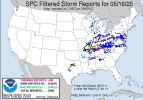N0mz
Member
The NIU Practically Perfect Hindcast, hosted at https://atlas.niu.edu/pperfect/, is either extremely flawed or deliberately cherrypicking data. I'm going to look at a few different high end forecasted events this year, and examine their SPC forecast (all 06z), SPC storm reports, and NIU practically perfect hindcast.
March 14



March 15



May 16



First off, the only of these three to "verify" a high risk is the March 15 event, which most consider not to have really verified the high risk. Meanwhile, the most robust event of the year, the March 14th outbreak, only verified a moderate risk, as well as the May 16th event, which featured two EF4s. On a more minute scale, I want to examine which points made it into the Practically Perfect system. On March 15, the only violent tornado of the day, the Tylertown EF4, has a boatload of polygons on the hindcast. However, on March 14th, far fewer tor reports made their way onto the hindcast even though there were objectively more tornadoes and significant tornadoes (104 vs 74 reports, 2 vs 1 EF4, 8 vs 3 EF3). At first, I thought this was because most of the March 14th tornadoes occurred after midnight and were not counted; however, the two Georgia reports on the March 15th hindcast were after midnight, per the DAT, and were included in the report. Finally, and perhaps most egregiously, the long-tracked, violent, and deadly Somerset-London tornado netted just two polygons in the May 16th hindcast!
Clearly, there is a serious flaw in the Practically Perfect system, and, although I don't want to go as far as to say data is being cherry-picked to artificially verify whatever the SPC outlook is, it sure does seem like it is. Thank you for listening to my yap session.
March 14



March 15



May 16



First off, the only of these three to "verify" a high risk is the March 15 event, which most consider not to have really verified the high risk. Meanwhile, the most robust event of the year, the March 14th outbreak, only verified a moderate risk, as well as the May 16th event, which featured two EF4s. On a more minute scale, I want to examine which points made it into the Practically Perfect system. On March 15, the only violent tornado of the day, the Tylertown EF4, has a boatload of polygons on the hindcast. However, on March 14th, far fewer tor reports made their way onto the hindcast even though there were objectively more tornadoes and significant tornadoes (104 vs 74 reports, 2 vs 1 EF4, 8 vs 3 EF3). At first, I thought this was because most of the March 14th tornadoes occurred after midnight and were not counted; however, the two Georgia reports on the March 15th hindcast were after midnight, per the DAT, and were included in the report. Finally, and perhaps most egregiously, the long-tracked, violent, and deadly Somerset-London tornado netted just two polygons in the May 16th hindcast!
Clearly, there is a serious flaw in the Practically Perfect system, and, although I don't want to go as far as to say data is being cherry-picked to artificially verify whatever the SPC outlook is, it sure does seem like it is. Thank you for listening to my yap session.


